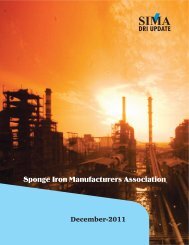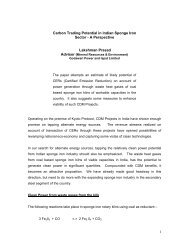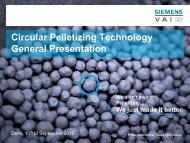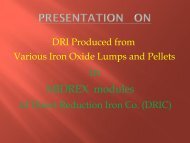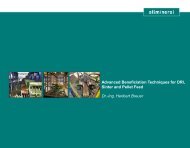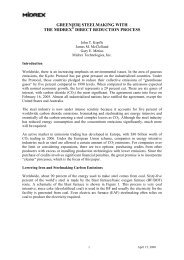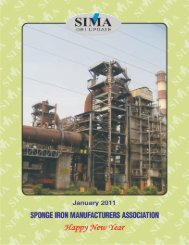You also want an ePaper? Increase the reach of your titles
YUMPU automatically turns print PDFs into web optimized ePapers that Google loves.
area of the DRI formed should be minimized. Since<br />
total surface area increases sharply with the fines<br />
content of the charge.<br />
(6) Feed Coal Sulfur Level<br />
As sulfur is introduced into the process by means of<br />
the feed end and blown coal, the sulfur level in the<br />
feed coals is an important consideration. Sulfur is<br />
present in the coal in inorganic form as pyritic sulfur<br />
or in organic or even sulfate form. Although the actual<br />
chemical form of the sulfur in the coal has been<br />
determined by experience to be not of great<br />
importance, still, regardless of its form, it poses a<br />
problem in the process and will, if not controlled,<br />
contaminate the DRI product. It follows that the higher<br />
the sulfur content of the coal the more effort is<br />
required to control that sulfur. As a result, regular<br />
analyses should be performed on the coals used in<br />
the process, and while the process may run<br />
acceptably with coals of up to 3% sulfur, it is<br />
preferred that coals with less than 2% be used.<br />
(7) Ore Feed Sulfur Level<br />
It has been found also that ore containing the iron<br />
oxide to be reduced in the process should have a<br />
less than 0.03% sulfur content or a weight percent<br />
of sulfur which is less than that desired in the DRI<br />
product.<br />
(8) Kiln Feed End Temperatures<br />
The oxidizing environment at the feed end of the<br />
kiln may be used to advantage in removing some of<br />
the sulfur from the kiln feeds. By operating at gas<br />
temperatures of greater than about 750.degree. C.<br />
in this region rapid “roasting” of the pyritic sulfur<br />
component in the feeds is promoted with the result<br />
that oxides of sulfur are rapidly formed and removed<br />
from the charge together with a proportion of the<br />
organic sulfur which is lost with volatile evolution.<br />
This high temperature operation substantially<br />
reduces the quantity of sulfur delivered to the high<br />
temperature reducing or “working” zone of the kiln<br />
where sulfur absorption into the product may occur.<br />
(9) Product Pellet Contamination<br />
“Tough times never last, tough people do.”<br />
Robert Schuller<br />
Contamination of the DRI pellet product by sulfurcontaining<br />
char, grease or the like, while one of the<br />
less complex factors affecting the product, may occur<br />
in a random manner so that it can be difficult to trace<br />
and eliminate. If either or both of these materials<br />
contaminates the product to any significant degree,<br />
unacceptably high sulfur levels can result. Detection<br />
of this contamination may be accomplished initially<br />
by visual inspection of the product on the separation<br />
section conveyor belts. If the grease condition is<br />
observed, the process should be stopped and any<br />
grease leakage into the cooler eliminated. The<br />
performance of the magnetic separators should be<br />
carefully monitored to avoid the return of any sulfur<br />
to the product stream, since if the magnetic field in<br />
a separator is too strong, it may draw DRIcontaminated<br />
char-containing sulfur into the product<br />
stream.<br />
Control and regulation of the above factors the direct<br />
reduction process may be continuously carried out<br />
with a resulting product having sulfur levels below<br />
desired level by weight in the DRI.<br />
MAY-<strong>2007</strong>/32



